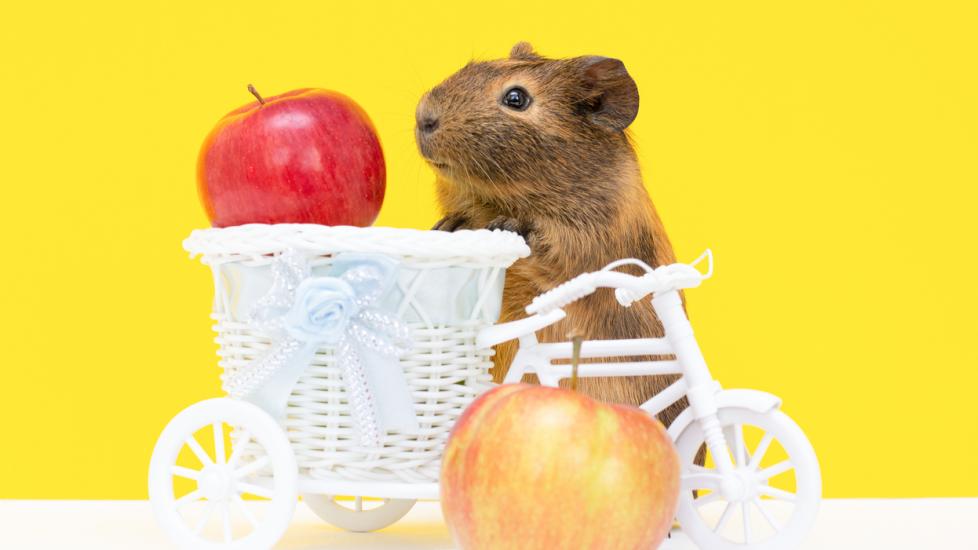Sounds of Guinea Pigs
What Sounds Do Guinea Pigs Make?
Guinea pigs, or cavies, are highly social animals. They typically have a male-dominated group hierarchy. As such social creatures, they have evolved a complex range of vocalizations, or sounds. Most of the vocalizations are methods of communication with other guinea pigs.
Guinea pigs typically have poor eyesight, so visual cues are not always helpful. It is important for pet owners to understand the basics of guinea pig vocalizations to help you better care for your guinea pigs.
Recommended Products
Why Do Guinea Pigs Squeak?
Squeaks come in all different kinds of frequencies, durations, and speeds. Guinea pig sounds can be generally categorized in the following manner:
-
Chuts, clucks, or clicks are brief sounds. They may happen just once or in pairs. When guinea pigs chut, they are usually exploring their area without alarm. It may be a quiet signal to other guinea pigs about their location or excitement level. Typically, it is a sign of contentment.
-
“Tutt-tutt-tutt” noises are made with varying degrees of frequency and are like chuts, although usually longer in duration. This is a sign of discomfort or fright, and may be followed by a whine or wheek. “Tutt-tutt” is a warning signal to other guinea pigs, who may respond in silent immobility while they wait to understand the threat.
-
Wheeks are loud, long, squeals. It is also known as a whistle or wheet. It generally indicates excitement in situations such as feeding time, playtime, or other positive experiences. This high-intensity vocalization may be in one or two parts, in different frequencies and durations.
-
Screaming, squealing, or shrieking sounds are high-pitched and generally mean the guinea pig is unhappy, in pain, or in danger. It is similar to a whistle, but without any low frequencies, and cavies typically emit them in rapid succession.
-
Chirping is an uncommon guinea pig vocalization. It sounds very close to a bird’s song. It is believed to be a general sign of low-level stress or discomfort. A baby guinea pig may emit this when they are hungry, for example. Some owners never hear their guinea pig chirp, or only hear it a few times during their life.
Why Do Guinea Pigs Purr?
Similar to cats, guinea pigs also purr. The unique frequencies of purring often indicate different things:
-
The low-pitched purr sounds like bubbling. Guinea pigs emit this when they are feeling content and safe. Owners will most often hear this when the guinea pig is being held, petted, groomed, and fed. They may also use this when exploring a new area or when snuggling with a favorite herd mate.
-
The high-pitched purr is stiff, short, and may indicate annoyance or stress. It may serve as a warning to other guinea pigs.
-
Rumbling is a sound normally made to exhibit dominance. It can also be a response to being scared or angry. The body may even vibrate in addition to the vocalization. Rumbling is typically not a sign of aggression, but if two animals both feel they are dominant, it could lead to a fight if neither backs down.
Boars, or male guinea pigs, perform a special type of rumbling, which includes walking around and emitting a low rumbling, while courting a sow, or female guinea pig. This courtship dance and vocalization is called rumblestrutting. Non-dominant animals may make a low rumble as they walk away from an aggressor. This indicates they are not pleased but do not wish to fight.
Other Guinea Pig Sounds
In addition to squeaks and purrs, guinea pigs may also exhibit the following sounds:
-
Grunts are an aggressive vocalization and usually mean there’s a brewing fight or attack. The grunt is a dominant noise made toward the subordinates in a herd.
-
Teeth chattering occurs when the teeth rapidly grind together. It is typically a warning or in response to a threat. Likely, the guinea pig that is chattering is indicating they are ready to fight. They may lift their head during this vocalization as well.
-
Hissing may sound like chattering teeth and is also a sign of aggression. Guinea pigs that are hissing want to be left alone. If not, the cavy may bite, which is generally not in their nature.
By learning about a wide range of sounds, pet parents can understand their guinea pigs better. Doing so can strengthen the bond between pet parent and cavy, and lead to happier and healthier pigs!
References
-
Johnson-Delaney, DVM, Dipl ABVP. Veterinary Information Network, Inc. Guinea Pig or Cavie (Cavia Porcellus) Pet Care. January 2021.
-
Guinea Lynx. Raising a Healthy Guinea Pig. 2022.
-
Pollock DVM, DABVP, Christal. Parmentier DVM, Sylvia. LafeberVet. Basic Information Sheet: Guinea Pig. October 2018.
-
Horton DVM, Susan. Chicago Exotics Animal Hospital. Guinea Pig Care.
-
San Diego Zoo Animals & Plants. Guinea Pig. 2022.
-
Oxbow Animal Health. Guinea Pig Sounds and Their Meanings. January 2021.
Featured Image: iStock.com/Irina Vasilevskaia
